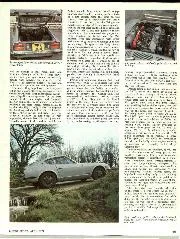

The Datsun 260Z
A worthwhile improvement of the World's best-selling sports car. More flexibility and performance from 2.6 litres, excellent roadholding and handling —an exciting and practical 2-seater At the 1969 Tokyo Motor…
AIR.
THE PUSHER-WHY NOT REVIVE IT?
A PLEA FOR ITS RE-ADOPTION.
in seeking means for improving the comfort, visibility and other points in the present-day light aeroplane, the writer of this article puts forward the suggestion that the pusher type should be reintroduced. While we do not necessarily agree with his views, we publish them as being of considerable interest.—ED.
ALTHOUGH the market for light aeroplanes .s steadily expanding, and new types and makes are being produced, one can discern—with one notable exception—little attempt on the part of designers at a breakaway from accepted, orthodox design.
It cannot be denied that the modern aircraft has advanced enormously in such vital points as controllability, ease of housing, strength, reliability and performance.
Yet if one compares the general arrangement of the typical biplane (which is far and a-.vay the most popular type) with that of a machine built fifteen or more years ago, the similarity is striking—and a little depressing to those who wish for a less slavish following of the ordinary, well-worn design. By this, one does not mean to advocate the introduction of freak types, or drastic, unreasoned attempts at “being different,” but a bolder move towards eradicating sundry bad features which are painfully noticeable in very nearly every aeroplane produced at the present time. These defects, which are obviously inherent to the tractor type are (1) discomfort through airscrew slipstream, and engine noise, (2) inferior visibility, and (3) difficulty in making entry and egress from cockpits. It is equally obvious that so long as the tractor is retained, no amount
of ingenuity on the designer’s part can satisfactorily eliminate all these, and one conies to the logical conclusion that only by adopting that lay-out which was popular in bygone years—the pusher—can comfort and convenience in flying be increased.
That this has not been carried out is, on the face of it, a little difficult to understand ; with the engine aft of the cockpit, and the pilot and passenger accommodated well forward it is possible to provide a greatly improved view all round, witile, as anyone who has flown in a pusher will agree, freedom from draught, vibration and drumming is a marked feature. Further consideration will show that it would be a simple matter to incorporate sideby-side seating in a pusher arrangement, since it would fall in well with a nacelle shaped in true streamline form, and an elaboration could be made to make the machine convertible from the open to the cabin type by means of a sliding roof and side panels without difficulty. It may be argued that if a prejudice exists against the pusher aeroplane, it is because it gained an unsavoury reputation in the early days. It is true that pushers have been involved in numbers of bad accidents, but the fault lay not so much in the fact that they were pushers, but rather that the design of the machines as a whole was un
sound, and that the engines were unsuitable and notoriously unreliable.
Nowadays, however, with vastly greater knowledge and precise technical data at their disposal, designers are able to avoid the pitfalls which they themselves and their predecessors met with in the past, and by applying the fruits of experience in reviving the pusher, they could, without doubt, evolve a machine which would lack none of the excellent characteristics of the tractor aircraft, and which, at the same time, would possess those qualities which are nowadays absent but none the less required.
Thus, the modern high-lift cantilever type wing could be embodied in the general arrangement, so as to give a wide speed range, antistalling characteristics, low-landing speed, and good load carrying capacity. At the same time dragproducing struts and bracing could be avoided, and mounted above and to the rear of a well streamlined nacelle, the whole would present a neat and clean assembly which would contribute towards the machine’s good performance. The recent development noticeable in engine design would also favour the constructor, especially in arranging the propeller’s thrust line to the best advantage, and here one immediately thinks of the in verted D.H. ” Gipsy ” or the compact, light and efficient Pobjoy unit. ” Airwheels ” and a split axle undercarriage could be incorporated to follow standard practice, and the structure connecting the tail-unit and the main body of the machine could be a combination of a box-type fuselage and tailbooins, or alternatively, simply tailbooms. Another point which was bad in old designs but which could be cleaned up, thanks to modern development, is the arrangement of elevator and rudder controls ; on such aircraft as the War-time F.E. these consisted of lengthy and complicated runs of cable, operating through numerous pulleys and fairleads, but with the Arens control system the modem pusher would not be so encumbered. Other up-to-date features come to mind by which the designer could eliminate all those faults which,
either in theory or practice, led to the scrapping of the pusher type, and the more one considers it, the more firmly one feels that the adoption of the “engine behind” principle would be well worth while. That sundry problems and difficulties would materialise in the evolution of an aircraft built on. the lines suggested there is no doubt. But is it unreasonable to ask—The pusher— why not revive it ?